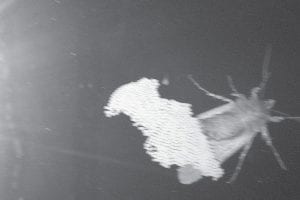When Deb Mueller saw this moth laying eggs on her window, she thought it was interesting and exciting and she snapped this photo. Unfortunately, the moth is likely laying eggs that will become variegated cutworms or Peridroma Saucia. Cutworm larvae will attack vegetable plants, as well as trees, vines, field crops and even house plants. Anyone with questions about cutworn eggs and larva is encouraged to call the Cook County Extension Office at (218) 387-3015.

There have been numerous calls to the Cook County Extension office over the past week about tiny white eggs about the size of the period in a sentence being found on windows and screens. These eggs are usually lined up singly in rows, not in any particular pattern, but in large numbers – in the hundreds. Under a microscope or good hand lens, these eggs have beautiful ridges on them and are really quite spectacular looking.
The eggs turn cream-colored and eventually brown before tiny larvae (caterpillars) emerge with black heads and nearly translucent bodies with black dots and sparse black hairs. Once again, they are so small, these details cannot be seen without a hand lens. They have three pairs of true legs and five pairs of small prolegs. These details lead us to believe they are probably variegated cutworms or Peridroma Saucia.
We won’t be absolutely sure until we can identify either the adult moth and/or a mature larvae form. While tiny now, they will feed on foliage, buds and shoots. The adults are night-flying moths that probably were blown up here on winds just in time to lay their eggs not only on local foliage but also were attracted to windows and siding on homes.
As they grow cutworm larvae will attack many common vegetable hosts as well as trees, vines, grasses, field crops, ornamentals and greenhouse plants. Since we don’t know yet the extent of the infestation and the ramifications as we go into the early summer, local gardeners may want to take some precautions by making sure paper or cardboard collars are placed around their transplants this year to protect them from cutworm damage.
The collars should be about 1 – 1.5 inches down into the soil, wrapped around the stem, and then left with about 1 – 1.5 inches above the soil line. This will discourage and prevent mature cutworm larvae from cutting plants off at the soil line.
Right now, while the eggs and larvae are tiny, it would be a good idea to remove them from windows and siding with soapy water. If they hatch and are blown off by the wind or drop to the ground, the larvae have the opportunity to continue growing and becoming more of a nuisance.
If you have additional questions, give the Cook County Extension office a call at 387- 3015.


Loading Comments